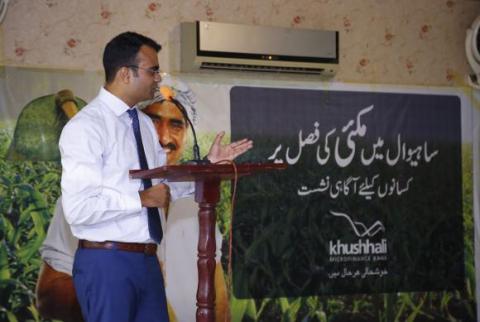
In October 2019 a session was arranged by KMBL to create awareness about Maize Crop for the farmers in Sahiwal area.
Dr. Zubair Ahmed (Scientific Officer (SO), MSM&F, CSI, NARC) talked on the topic of “Climate change & mitigation of environmental stresses, adaptation of efficient production technologies to increase maize yield and Biofortified maize”. He gave a brief introduction of maize and explained the current status of maize in the world and Pakistan. World wide maize is cultivated on an area of 193.14 million ha, with the production of 1133.6 million tons, the average grain yield of maize in the world is 3.77 tons/ha. In the same way, in Pakistan maize is cultivated on 1.31 million ha with the total production of 6.3 million tons and the average grain yield in Pakistan is 4.8 tones/ha.
He explained the potential difference between maize hybrids and varieties, nutritive values of maize and its uses, climatic & soil requirements for maize production, complete production technology from land preparation, sowing methods, fertilizer use, weeds & pest management, diseases of maize and their control to harvesting/post-harvest losses and control.
He explained the phenomena of climate change, worldwide losses due to heat & drought stress, flooding, increased incidences of biotic stresses, soil depletion and reduction in cropped area. His main focus was on heat stress. Heat stress devastated maize crop in Punjab this year. Audience was explained about the maize plant responses and adaptations to heat stress, effects of rise in day and night temperatures, poor pollen fertility and reduced silk receptivity under heat stress conditions. He also explained the results of an experiment conducted at NARC on maize to check the pollen viability under heat stress conditions. During the presentation various solutions were suggested to the farmers for heat stress management by carefully selection of sowing time and other practices.
During the interactive session audience were also explained about quality protein hybrid maize (QPHM). QPHM is rich in two amino acid lysine and tryptophan, both are essential for normal growth. These amino acids are not present in normal maize hybrids/varieties. With the use of these hybrids’ malnutrition can be overcome, especially in areas where maize is used as staple food.
During and after the interactive session expert answered the questions of the farming community.